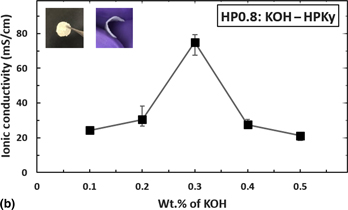Crossref Citations
This article has been cited by the following publications. This list is generated based on data provided by
Crossref.
Muhammed, Dana S.
Brza, Mohamad A.
M. Nofal, Muaffaq
B. Aziz, Shujahadeen
A. Hussen, Sarkawt
and
Abdulwahid, Rebar T.
2020.
Optical Dielectric Loss as a Novel Approach to Specify the Types of Electron Transition: XRD and UV-vis as a Non-Destructive Techniques for Structural and Optical Characterization of PEO Based Nanocomposites.
Materials,
Vol. 13,
Issue. 13,
p.
2979.
Zhou, Jingwen
Cheng, Jianli
Wang, Bin
Peng, Huisheng
and
Lu, Jun
2020.
Flexible metal–gas batteries: a potential option for next-generation power accessories for wearable electronics.
Energy & Environmental Science,
Vol. 13,
Issue. 7,
p.
1933.
Arora Abrol, Shivani
Bhargava, Cherry
and
Sharma, Pardeep Kumar
2021.
Material and its selection attributes for improved DSSC.
Materials Today: Proceedings,
Vol. 42,
Issue. ,
p.
1477.
Poosapati, Aswani
Vadnala, Sudharshan
Negrete, Karla
Lan, Yucheng
Hutchison, John
Zupan, Mark
and
Madan, Deepa
2021.
Rechargeable Zinc-Electrolytic Manganese Dioxide (EMD) Battery with a Flexible Chitosan-Alkaline Electrolyte.
ACS Applied Energy Materials,
Vol. 4,
Issue. 4,
p.
4248.
Li, Shengnan
Cong, Yang
and
Fu, Jun
2021.
Tissue adhesive hydrogel bioelectronics.
Journal of Materials Chemistry B,
Vol. 9,
Issue. 22,
p.
4423.
Sun, Zhe
Qu, Keqi
You, Yue
Huang, Zhanhua
Liu, Shouxin
Li, Jian
Hu, Qian
and
Guo, Zhanhu
2021.
Overview of cellulose-based flexible materials for supercapacitors.
Journal of Materials Chemistry A,
Vol. 9,
Issue. 12,
p.
7278.
Poosapati, Aswani
Negrete, Karla
Thorpe, Micah
Hutchison, John
Zupan, Mark
Lan, Yucheng
and
Madan, Deepa
2021.
Safe and flexible chitosan‐based polymer gel as an electrolyte for use in zinc‐alkaline based chemistries.
Journal of Applied Polymer Science,
Vol. 138,
Issue. 33,
Wei, Yuantao
Shi, Yuchuan
Chen, Ye
Xiao, Chunhui
and
Ding, Shujiang
2021.
Development of solid electrolytes in Zn–air and Al–air batteries: from material selection to performance improvement strategies.
Journal of Materials Chemistry A,
Vol. 9,
Issue. 8,
p.
4415.
Song, Seo Won
Kim, Hongdeok
Shin, Seoyoon
Jang, Seongjin
Bae, Jong Hyuk
Pang, Changhyun
Choi, Joonmyung
and
Yoon, Ki Ro
2023.
Hierarchically porous hydrogel electrolyte prepared from interpenetrating polymer networks for flexible Zn-Air batteries.
Energy Storage Materials,
Vol. 60,
Issue. ,
p.
102802.
Li, Han
Chen, Jun
and
Fang, Jian
2023.
Recent Advances in Wearable Aqueous Metal‐Air Batteries: From Configuration Design to Materials Fabrication.
Advanced Materials Technologies,
Vol. 8,
Issue. 8,
Balboni, Raphael D.C.
Cholant, Camila M.
Lemos, Rafaela M.J.
Rodrigues, Lucas S.
Carreno, Neftali L.V.
Santos, Marcos J.L.
Avellaneda, Cesar A.O.
and
Andreazza, Robson
2024.
Highly transparent sustainable biogel electrolyte based on cellulose acetate for application in electrochemical devices.
International Journal of Biological Macromolecules,
Vol. 265,
Issue. ,
p.
130757.
Tang, Xue
Huang, Lijun
Zhu, Qingtao
Zhou, Lijun
Xiao, Lei
Chen, Junyan
Chen, Jiabin
Liu, Zhigao
and
Yuan, Quanping
2025.
A high-performance regenerated cellulose based moist-electric device with dual mechanism of ion gradient diffusion and streaming potential by in-situ loading metal oxide.
Composites Part B: Engineering,
Vol. 307,
Issue. ,
p.
112912.
Hazarika, Dipankar
Kamei, Duangailung
Shijoh, Nuphizo
and
Choudhury, Nurul Alam
2025.
An ionically cross-linked chitosan hydrogel membrane electrolyte for long-lived electrical double layer capacitors.
Journal of Power Sources,
Vol. 629,
Issue. ,
p.
236037.
Shijoh, Nuphizo
Hazarika, Dipankar
Kichu, Marjo A
Kamei, Duangailung
and
Choudhury, Nurul Alam
2025.
Al3+-crosslinked gelatin hydrogel membrane: A high-stability electrolyte for durable electrical double layer capacitors.
Journal of Power Sources,
Vol. 659,
Issue. ,
p.
238409.


